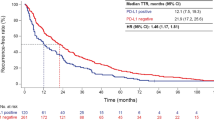Abstract
Objectives
To analyze the association of paraneoplastic syndromes (PNS) with progression-free (PFS) and cancer-specific survival (CSS) among patients with renal cell carcinoma (RCC) undergoing nephrectomy.
Methods
We performed a retrospective analysis of 2865 patients undergoing nephrectomy for localized RCC at Mayo Clinic from 1990 to 2010. PNS analyzed were anemia, polycythemia, hypercalcemia, recent-onset hypertension, and liver dysfunction. PFS and CSS were estimated using Kaplan–Meier method and compared with Cox proportional hazard models, unadjusted and adjusted for clinicopathologic features.
Results
A total of 661 (23 %) patients had anemia, 37 (1 %) had polycythemia, 177 (9 %) had hypercalcemia, 51 (2 %) had recent-onset hypertension, and 224 (10 %) had liver dysfunction at time of nephrectomy. Patients with PNS were more likely to have high-grade tumors and advanced disease stages. A total of 675 (24 %) patients developed progression and 1171 (41 %) died of RCC, over a median follow-up of 8.2 years. On univariable analysis, the presence of any PNS was associated with inferior CSS [hazard ratio (HR) = 1.86, p = 0.007] and a trend toward shorter PFS (HR = 1.33, p = 0.07) compared with patients without PNS. Specifically, anemia, polycythemia, hypercalcemia, and liver dysfunction were each associated with inferior CSS and PFS (all p < 0.05). However, on multivariable analysis PNS (overall or each individual syndrome) did not remain independently associated with CSS or PFS.
Conclusions
Patients with RCC undergoing nephrectomy presenting with PNS have worse oncologic outcome than those with incidentally found tumors. However, the adverse outcome among PNS patients seems to be largely explained by adverse pathologic features of these tumors.
Similar content being viewed by others
References
Sacco E, Pinto F, Sasso F et al (2009) Paraneoplastic syndromes in patients with urological malignancies. Urol Int 83:1–11
Gold PJ, Fefer A, Thompson JA (1996) Paraneoplastic manifestations of renal cell carcinoma. Semin Urol Oncol 14:216–222
Pepper K, Jaowattana U, Starsiak MD et al (2007) Renal cell carcinoma presenting with paraneoplastic hypercalcemic coma: a case report and review of the literature. J Gen Intern Med 22:1042–1046
Jobe BA, Bierman MH, Mezzacappa FJ (1993) Hyperglycemia as a paraneoplastic endocrinopathy in renal cell carcinoma: a case report and review of the literature. Nebr Med J 78:349–351
Laski ME, Vugrin D (1987) Paraneoplastic syndromes in hypernephroma. Semin Nephrol 7:123–130
Marshall FF, Walsh PC (1977) Extrarenal manifestations of renal cell carcinoma. J Urol 117:439–440
Giannakos G, Papanicolaou X, Trafalis D, Michaelidis I, Margaritis G, Christofilakis C (2005) Stauffer’s syndrome variant associated with renal cell carcinoma. Int J Urol Off J Jpn Urol Assoc 12:757–759
Kim HL, Belldegrun AS, Freitas DG et al (2003) Paraneoplastic signs and symptoms of renal cell carcinoma: implications for prognosis. J Urol 170:1742–1746
Napal LS, Pascual PJI, Solchaga MA, Arrondo AJL, Ipiens AA (1992) Polycythemia as the first and only manifestation of renal adenocarcinoma. Arch Esp Urol 45:476–478
Papac RJ, Poo-Hwu WJ (1999) Renal cell carcinoma: a paradigm of lanthanic disease. Am J Clin Oncol 22:223–231
Chow WH, Dong LM, Devesa SS (2010) Epidemiology and risk factors for kidney cancer. Nat Rev Urol 7:245–257
Lee CT, Katz J, Fearn PA, Russo P (2002) Mode of presentation of renal cell carcinoma provides prognostic information. Urol Oncol. 7:135–140
Magera JS Jr, Leibovich BC, Lohse CM et al (2008) Association of abnormal preoperative laboratory values with survival after radical nephrectomy for clinically confined clear cell renal cell carcinoma. Urology 71:278–282
Kim HL, Han KR, Zisman A, Figlin RA, Belldegrun AS (2004) Cachexia-like symptoms predict a worse prognosis in localized t1 renal cell carcinoma. J Urol 171:1810–1813
Fine JP, Gray RJ (1999) A proportional hazards model for the subdistribution of a competing risk. J Am Stat Assoc 94:496–509
Palapattu GS, Kristo B, Rajfer J (2002) Paraneoplastic syndromes in urologic malignancy: the many faces of renal cell carcinoma. Rev Urol 4:163–170
Ding GX, Song NH, Feng CC et al (2012) Is there an association between advanced stage of renal cell carcinoma and paraneoplastic syndrome? Med Princ Pract 21:370–374
Authors’ contribution
Moreira developed the project, analyzed data, and wrote the manuscript; Gershman: developed the project and edited the manuscript; Lohse was involved in data management and data analysis; Boorjian developed the project and edited the manuscript; Cheville collected data and edited the manuscript; Leibovich was involved in administrative support, manuscript editing, and supervision; and Thompson was involved in project development and supervision.
Author information
Authors and Affiliations
Corresponding author
Ethics declarations
Conflict of interest
No conflict of interests to disclose.
Informed consent
The study was reviewed and approved by an IRB. Given the minimal risk nature of the study, informed consent was waived.
Rights and permissions
About this article
Cite this article
Moreira, D.M., Gershman, B., Lohse, C.M. et al. Paraneoplastic syndromes are associated with adverse prognosis among patients with renal cell carcinoma undergoing nephrectomy. World J Urol 34, 1465–1472 (2016). https://doi.org/10.1007/s00345-016-1793-7
Received:
Accepted:
Published:
Issue Date:
DOI: https://doi.org/10.1007/s00345-016-1793-7




